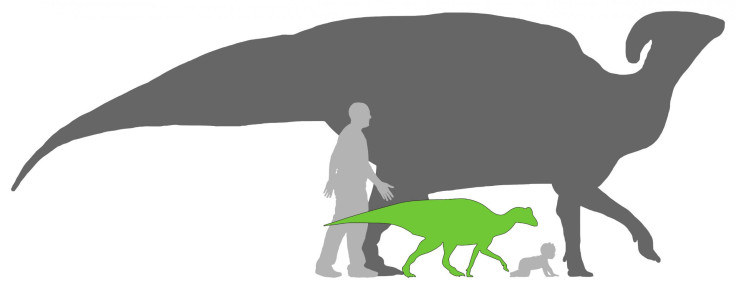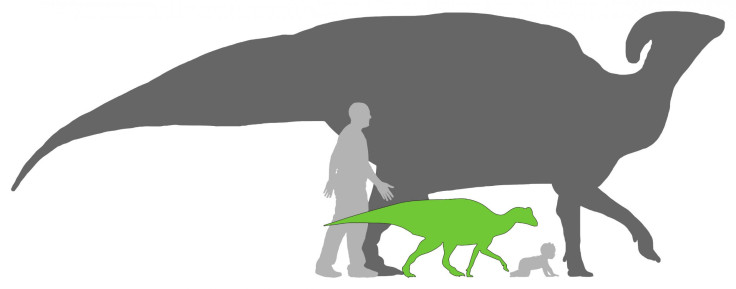'Dinosaur Joe' Might Be Most Complete Parasaurolophus Ever Discovered -- And He Was Found By A Teenager
A lot of kids spend the summer between high school and college working at the local ice cream shop or swimming pool; Kevin Terris spent those months looking for dinosaurs. And what Terris found out in the Utah back country turned out to be even more significant than he expected.
In 2009, Terris, along with other students from the Webbs Schools in Claremont, Calif., was out on a field dig at the Grand Staircase-Escalante National Monument in southern Utah. It was the second to last day of the digging season, and Terris was hiking with Andrew Farke, a curator at the Webb Schools' paleontology museum. They were out prospecting -- looking for weathered pieces where the elements had exposed some facet of a fossil or bit of bone, as opposed to just digging randomly. As he was climbing a hill, Terris spied something protruding on the underside of a nearby mushroom-shaped sandstone formation. He called Farke over.
At first, Farke didn’t think the find was much – maybe, at most, a fragment of a dinosaur rib. Not that scientifically significant, and certainly not worth the trouble of cracking through the dense, concrete-like stone. (Grand Staircase-Escalante is rugged terrain, very hilly and rocky, with few roads, so getting supplies in and out is a major headache.) The pair turned to leave, but something drew them back. Opposite from the little protrusion, there was a loose cobble of stone.
“As soon as we flipped that over, we saw the skull,” Terris says.
Closer examination of the other side of the rock revealed the unassuming protrusion to be some toe bones. Between the toes and the skull, Terris and Farke wagered, must be a whole dinosaur.
After two field seasons' worth of excavation work – requiring jackhammers and chisels to split the sandstone, layers of burlap and plaster placed to protect the bones, and a helicopter to airlift the 800-pound specimen out of the Utah wilds – the rock yielded up the ghost: a young specimen of the crested hadrosaur Parasaurolophus.

“It’s a little embarrassing for me, because I walked by that very spot a couple times earlier that season,” Farke says.
And the find wasn’t just a regular old Parasaurolophus. It was the most complete Parasaurolophus fossil Farke had heard of to date. The skeleton was remarkably whole, missing just the tip of the tail, the arms below the elbow, and other small bones. Farke and a group of researchers (including three Webb Schools students) describe the fossil in a paper appearing Tuesday in the open-access journal PeerJ. The specimen is currently on display at the Webb Schools' Raymond M. Alf Museum of Paleontology.
Though the young Parasaurolophus is nicknamed “Joe” (after Joseph Augustyn, a longtime supporter of the Webb Schools and its paleontology museum), it might actually be a Josephine. Currently, there’s no method to determine the dinosaur’s sex.
Joe's age, however, was determined by co-author and University of California, Berkeley, scientist Sarah Werning by slicing open a sample of his leg bone. Animal bones, like trees, put down ring-like deposits throughout the years. Joe’s bone had no growth rings at all – he was still in the midst of a major growth spurt in his first year of life.
"It's a truly remarkable specimen of a rare and iconic dinosaur," University of Toronto paleontologist David Evans wrote in an email. "Complete skeletons of baby dinosaurs like this are extremely rare, but are important for providing detailed data on the life history of particular species, which can lead to significant insights into their biology and evolution."

Though he was six feet long when he died, Joe would have been dwarfed by his parents, who could have been more than 30 feet long.
Joe’s Utah of 75 million years ago was very different from today's. It was a lush landscape more comparable to the Florida Everglades or the tropical portions of Mexico. Joe would have lived his short life alongside flying reptiles, other hadrosaurs, and even Tyrannosaurus Rex. After his untimely death, Joe’s body probably was washed into a stream channel and buried. Time did the rest.
What killed Joe? It’s hard to say. The posture of his skeleton – arched neck, tail straight, limbs curled – isn’t unusual among fossils.
“There’s no evidence of disease on the bones, and no obvious evidence of a predator attack,” Farke says. “The bones are well put-together. They’ll really get torn apart if some predator attacked them.”
If you want to investigate Joe for yourself, Farke and his team have posted all of their data on a public to a new dedicated website. There are photos, CAT scans of the fossil, surface scans, and three-dimensional models. If you have a 3D printer, you can print out your very own Joe.
“Our goal is to make Joe the most digitally accessible dinosaur ever described,” Farke says.
Joe is already contributing to our understanding of his kind. One thing that Farke and his team were surprised to find was that, even at his young age and a quarter of his adult size, Joe sported the beginnings of the Parasaurolophus’s trademark sweeping crest. Hadrosaurs aren’t born with their crests, but scientists weren’t quite sure when various species began growing their headgear. While other dinosaurs with simpler crests held off on forming theirs until they were half-grown, the Parasaurolophus strategy seems to have been to start early and grow rapidly.

Paleontologists have long been fascinated by the Parasaurolophus’s crest, a long, hollow bony tube that sweeps back from the skull. Harvard paleontologist Alfred Romer theorized in the 1960s that it could have been used like a snorkel while the dinosaur foraged for food in the water; this theory fell apart with the evidence showing the crest had no hole at its tip to allow air in. Other theories – that the crest was used in combat when the dinosaurs butted heads, or even that it housed glands that allowed Parasaurolophus to spew chemicals at its enemies – have similarly fallen by the wayside.
Today, two major theories about the crest are in contention. It may have been a simple visual signal, allowing a Parasaurolophus to pick out members of its own tribe. Others hypothesize that the crest may have been a conductor for sound. The tube of the crest is partially an extension of the nasal passages. If the dinosaur made a sound in its throat, it might have resonated up through the crest and produced some spectacular noises.
Joe, with his tiny crest, "would have been a little squeaker, while the big guys with the big long crests would have made a booming sound," Farke says.
The Parasaurolophus's amplified calls might have functioned like birdsong, used to establish territory or even in courtship rituals.
“Think of the mating rituals in Birds of Paradise, for instance, which are, after all dinosaurs of the avian variety,” John Cisne, a Cornell paleontologist not affiliated with the current study, wrote in an email. “For all we’re likely ever to know, crested ornithopods like Parasaurolophus could have been the dancing Birds of Paradise of their time, or at the very least, the Philadelphia Mummers.”
Terris, meanwhile, is now studying paleontology at Montana State University. He’s interested in going out on more digs and exploring the evolutionary history of one of his favorite dinosaur groups – the cerotopsids, which include classics like Triceratops. He still feels lucky to have found Joe.
“The running joke in paleontology is something like: Every kid loves dinosaurs; those who continue in the field just never grew up,” Terris says.
SOURCE: Farke et al. “Ontogeny in the tube-crested dinosaur Parasaurolophus (Hadrosauridae) and heterochrony in hadrosaurids.” PeerJ published online 22 October 2013.
© Copyright IBTimes 2024. All rights reserved.





















